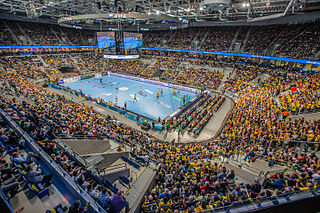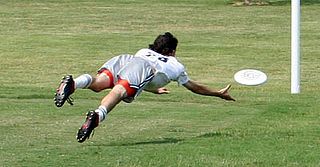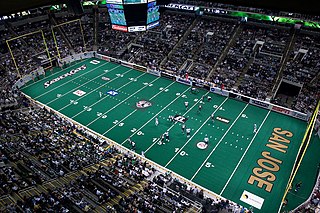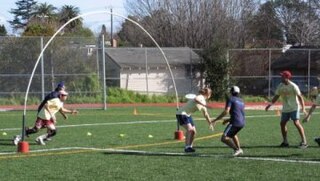Related Research Articles

Canadian football, or simply football, is a sport in Canada in which two teams of 12 players each compete on a field 110 yards (101 m) long and 65 yards (59 m) wide, attempting to advance a pointed oval-shaped ball into the opposing team's end zone.

The end zone is the scoring area on the field, according to gridiron-based codes of football. It is the area between the end line and goal line bounded by the sidelines. There are two end zones, each being on an opposite side of the field. It is bordered on all sides by a white line indicating its beginning and end points, with orange, square pylons placed at each of the four corners as a visual aid. Canadian rule books use the terms goal area and dead line instead of end zone and end line respectively, but the latter terms are the more common in colloquial Canadian English. Unlike sports like association football and ice hockey which require the ball/puck to pass completely over the goal line to count as a score, both Canadian and American football merely need any part of the ball to break the vertical plane of the outer edge of the goal line.

Handball is a team sport in which two teams of seven players each pass a ball using their hands with the aim of throwing it into the goal of the opposing team. A standard match consists of two periods of 30 minutes, and the team that scores more goals wins.

Ultimate, originally known as ultimate frisbee, is a non-contact team sport played with a disc flung by hand. Ultimate was developed in 1968 by Joel Silver in Maplewood, New Jersey. Although ultimate resembles many traditional sports in its athletic requirements, it is unlike most sports due to its focus on self-officiating, even at the highest levels of competition. The term "frisbee" is a registered trademark of the Wham-O toy company, and thus the sport is not formally called "ultimate Frisbee", though this name is still in common casual use. Points are scored by passing the disc to a teammate in the opposing end zone. Other basic rules are that players must not take steps while holding the disc, and interceptions, incomplete passes, and passes out of bounds are turnovers. Rain, wind, or occasionally other adversities can make for a testing match with rapid turnovers, heightening the pressure of play.
Guts or disc guts is a disc game inspired by dodgeball, involving teams throwing a flying disc at members of the opposing team.

Touch football is an amateur variant of American football and Canadian football. The basic rules are similar to those of the mainstream game, but to end a down, the person carrying the ball need only be touched, instead of tackled, by a member of the opposite team. This rule change gave the game its name, to differentiate it from other variants. It is similar to street football, another amateur variant, however in street football full contact is allowed.

A touchdown is a scoring play in gridiron football. Whether running, passing, returning a kickoff or punt, or recovering a turnover, a team scores a touchdown by advancing the ball into the opponent's end zone. More specifically a touchdown is when any part of the football, in the possession of an offensive player, crosses the goal line while the player, as well as the ball, is inbounds, and the player is upright. In order for a player to be down, any part of their body other than their hands or feet must touch the ground. If a player falls down without being contacted by a defensive player, whether or not they are down varies by league.

Tag is a playground game involving one or more players chasing other players in an attempt to "tag" and mark them out of play, usually by touching with a hand. There are many variations; most forms have no teams, scores, or equipment. Usually, when a person is tagged, the tagger says, "Tag, you're 'It'!". The last one tagged during tag is "It" for the next round. The game is known by other names in various parts of the world, including "running and catching" in India and "catch and cook" in the Middle East.

Arena football is a variety of eight-man indoor gridiron football. The game is played indoors on a smaller field than American or Canadian football, designed to fit in the same surface area as a standard North American ice hockey rink, resulting in a faster and higher-scoring game that can be played on the floors of indoor arenas. The sport was invented in 1981, and patented in 1987, by Jim Foster, a former executive of the National Football League and the United States Football League. The name is trademarked by Gridiron Enterprises and had a proprietary format until its patent expired in 2007.

Beer die, beer dye or snappa is a table-based drinking game in which opposing players sit or stand at opposite ends and throw a die over a certain height with the goal of either landing the die in their opponent's cup or having the die hit the table and bounce over the scoring area to the floor. The defending team attempts to catch the die one-handed after it hits the table, but before it touches a non-table surface. The game typically consists of two two-player teams with each of the four players having a designated cup on the table, but can also be played one-vs-one.

Goaltimate is a half-court disc game derived from ultimate, similar to hot box. The object is to score points by throwing a flying disc to a teammate in a small scoring area, through a large semicircular hoop called the goal. The name is a portmanteau of "goal" and "ultimate".

Gameplay in American football consists of a series of downs, individual plays of short duration, outside of which the ball is or is not in play. These can be plays from scrimmage – passes, runs, punts or field goal attempts – or free kicks such as kickoffs and fair catch kicks. Substitutions can be made between downs, which allows for a great deal of specialization as coaches choose the players best suited for each particular situation. During a play, each team should have no more than 11 players on the field, and each of them has specific tasks assigned for that specific play.

Kho kho is a traditional Indian sport that dates back to ancient India. It is the second-most popular traditional tag game in the Indian subcontinent after kabaddi. Kho kho is played on a rectangular court with a central lane connecting two poles which are at either end of the court. During the game, nine players from the chasing team are on the field, with eight of them sitting (crouched) in the central lane, while three runners from the defending team run around the court and try to avoid being touched. Each sitting player on the chasing team faces the opposite half of the field that their adjacent teammates are facing.
Flickerball is a group sport played with an American football in similar situations to dodgeball, such as Gym Class/PE classes. It is played in a group of 6 to 40 players who are equally divided into two teams. The teams separate on opposite sides of an area such a gymnasium, parking lot, or field. The game is unstructured in terms of what constitutes or if there will be outs and the length of play nor time-outs. There are many rules and the game is structured most similarly to Ultimate Frisbee. One notable exception is that any shot on goal results in the ball going out of bounds which results in an automatic change of possession. This rule should mitigate wild shots hoping for statistical points.
The game of lacrosse is played using a combination of offensive and defensive strategies. Offensively, the objective of the game is to score by shooting the ball into an opponent's goal, using the lacrosse stick to catch, carry, and pass the ball. Defensively, the objective is to keep the opposing team from scoring and to dispossess them of the ball through the use of stick checking and body contact or positioning.
The following terms are used in American football, both conventional and indoor. Some of these terms are also in use in Canadian football; for a list of terms unique to that code, see Glossary of Canadian football.
A comparison of Canadian football and rugby union is possible because of the games' shared origins, despite their dissimilarities.

Ultimate Ascent was the 2013 FIRST Robotics Competition game. It is styled similarly to disc golf.

The Premier Ultimate League (PUL) is a professional women's ultimate disc league that formed in 2019. The mission of the PUL is "to achieve equity in the sport of ultimate by increasing accessibility to the sport for, and visibility of women, transgender, intersex, non-binary, genderqueer, and genderfluid people through high-quality competition, leadership experiences, and community partnerships". The league strives for gender, racial, and economic diversity in the sport of ultimate frisbee. PUL players are paid $40 per league game.